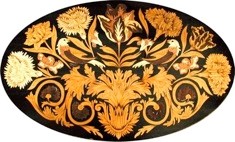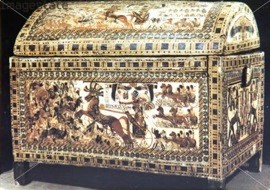Marquetry is fun and easy! Tools for getting started can be as simple as a few scraps of veneer, an X-Acto knife, a straightedge, and a roll of masking tape. As your skills grow, you can add other tools as needed.
Marquetry (also spelled as marqueterie) is the art and craft of applying thin pieces of wood (or other materials such as shell or ivory) veneer to a structure to form decorative patterns, designs or pictures. The technique may be applied to case furniture or even seat furniture, to decorative small objects with smooth, veneerable surfaces or to freestanding pictorial panels appreciated in their own right. Parquetry is very similar in technique to marquetry: in the former the pieces of veneer are of simple repeating geometric shapes, forming tiling patterns such as would cover a floor (parquet), or forming basketweave or brickwork patterns, trelliswork and the like.
Marquetry (and parquetry too) differs from the more ancient craft of inlay, or intarsia, in which a solid body of one material is cut out to receive sections of another to form the surface pattern. The word derives from a Middle French word meaning “inlaid work”.
While the exact origins of marquetry are unknown, it is known that ancient artisans devised techniques to create objects decorated with exquisite inlays of wood, stone, metal, shell, bone, ivory and other exotic materials. They would carve out a recess and fill in the resulting void with the material of their choice, using glues made by heating the bones or skins of animals or fish. Egyptian hieroglyphs and paintings indicate that veneers were cut with bronze adzes and applied as decorative elements to caskets. At this time mosaic work was also widespread, so it can be imagined that it did not take long for craftsmen to start experimenting with designs formed from different veneers.
Painted and inlaid coffer from the Treasure of Tutankhamen
Ancient Egyptian (c1325 BC), Unknown Artist
In the mid-16th century, innovations in spring-driven clocks resulted in the development of the fretsaw, a handheld tool which could be used to precisely cut inlay elements. With the ability to now very accurately cut thin sheets of wood, bone, ivory, shell and other materials into nearly arbitrary complex shapes, 16th century craftsman began to piece together these materials and shapes into more complex images. The approach, now termed “marquetry” from the French marqueter (“to inlay as on a piece of furniture”), involved the cutting, fitting and gluing of pieces of material into a single sheet and then gluing the resulting sheet down onto a substrate. As such, marquetry differed substantially from inlay in that the design was essentially completed before being attached to the end piece of furniture, rather than being used as an element within the end piece. The earliest known example of marquetry (1563) is from Breslau, Germany (see figure below).

Marquetry Panel from the Rathaus, Breslau,
Germany 1563
Over the next few centuries, marquetry schools were established in France, Germany and Holland. During the 16th to 18th centuries much exquisite work was produced focused primarily on decorating furniture, and by the early 17th century, marquetry largely replaced inlaid decoration in furniture.
 William & Mary Seaweed Marquetry Cabinet on Chest
William & Mary Seaweed Marquetry Cabinet on Chest
Eventually, marquetry extended westward from Europe to America and beyond. Today there are a handful of professional marquetarians, however, it is often the amateur who produces some of the finest work. Unrestricted by commercial concerns, they are able to develop new techniques which are often labor intensive, advancing this unique art form to new standards.

